Related Research Articles
An oratorio is a large musical composition for orchestra, choir, and soloists. Like most operas, an oratorio includes the use of a choir, soloists, an instrumental ensemble, various distinguishable characters, and arias. However, opera is musical theatre, while oratorio is strictly a concert piece – though oratorios are sometimes staged as operas, and operas are sometimes presented in concert form. In an oratorio, the choir often plays a central role, and there is generally little or no interaction between the characters, and no props or elaborate costumes. A particularly important difference is in the typical subject matter of the text. Opera tends to deal with history and mythology, including age-old devices of romance, deception, and murder, whereas the plot of an oratorio often deals with sacred topics, making it appropriate for performance in the church. Catholic composers looked to the lives of saints and histories from the Bible while Protestant composers only to Biblical topics. Oratorios became extremely popular in early 17th-century Italy partly because of the success of opera and the Catholic Church's prohibition of spectacles during Lent. Oratorios became the main choice of music during that period for opera audiences.

Heinrich Schütz was a German early Baroque composer and organist, generally regarded as the most important German composer before Johann Sebastian Bach, as well as one of the most important composers of the 17th century. He is credited with bringing the Italian style to Germany and continuing its evolution from the Renaissance into the Early Baroque. Most of his surviving music was written for the Lutheran church, primarily for the Electoral Chapel in Dresden. He wrote what is traditionally considered the first German opera, Dafne, performed at Torgau in 1627, the music of which has since been lost, along with nearly all of his ceremonial and theatrical scores. Schütz was a prolific composer, with more than 500 surviving works.
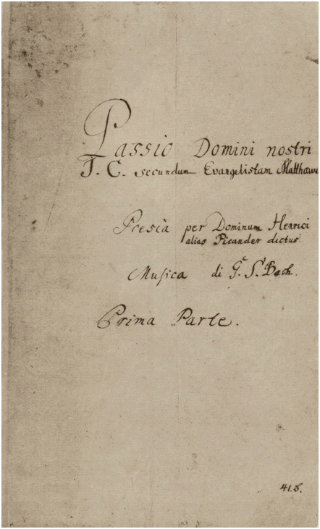
The St Matthew Passion, BWV 244, is a Passion, a sacred oratorio written by Johann Sebastian Bach in 1727 for solo voices, double choir and double orchestra, with libretto by Picander. It sets the 26th and 27th chapters of the Gospel of Matthew to music, with interspersed chorales and arias. It is widely regarded as one of the greatest masterpieces of Baroque sacred music. The original Latin title Passio Domini nostri J.C. secundum Evangelistam Matthæum translates to "The Passion of our Lord J[esus] C[hrist] according to the Evangelist Matthew".

The Seven Last Words of Our Saviour on the Cross is an orchestral work by Joseph Haydn, commissioned in 1786 for the Good Friday service at Oratorio de la Santa Cueva in Cádiz, Spain. Published in 1787 and performed then in Paris, Rome, Berlin and Vienna, the composer adapted it in 1787 for string quartet, approved a version for solo piano in the same year, and finally adapted it in 1796 as an oratorio.

The Three Hours' Agony is a Christian service held in many Roman Catholic, Lutheran, Anglican and Methodist churches on Good Friday from noon till 3 p.m. to commemorate the three hours of Christ's hanging at the cross.
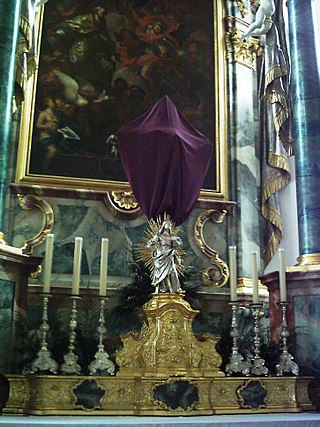
Passiontide is a name for the last two weeks of Lent, beginning on the Fifth Sunday of Lent, long celebrated as Passion Sunday, and continuing through Lazarus Saturday. It commemorates the suffering of Christ. The second week of Passiontide is Holy Week, ending on Holy Saturday.
František Xaver Brixi was a Czech classical composer of the 18th century. His first name is sometimes given by reference works in its Germanic form, Franz.

Jesu, der du meine Seele, BWV 78 is a church cantata of Johann Sebastian Bach. He composed the chorale cantata in Leipzig for the 14th Sunday after Trinity and first performed it on 10 September 1724. It is based on the hymn by Johann Rist.
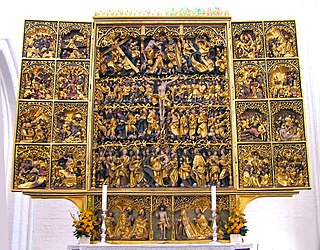
In Christian music, a Passion is a setting of the Passion of Christ. Liturgically, most Passions were intended to be performed as part of church services in the Holy Week.
Agnès Mellon is a French soprano who specializes in baroque music.
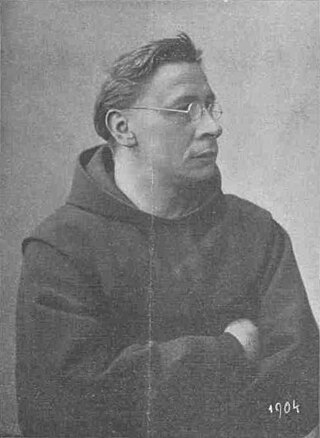
Hartmann von An der Lan-Hochbrunn, O.F.M., was an Austrian Friar Minor and Catholic priest, who worked as a composer, organist and conductor.
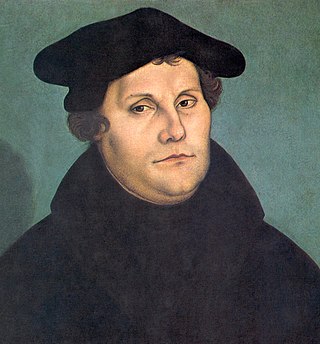
Gelobet seist du, Jesu Christ, BWV 91, is a church cantata by Johann Sebastian Bach. He wrote the Christmas cantata in Leipzig in 1724 for Christmas Day and first performed it on 25 December 1724. The chorale cantata is based on the hymn "Gelobet seist du, Jesu Christ" (1524) by Martin Luther.
Berthold Klemens Possemeyer is a German baritone in opera and concert, and a voice teacher at the University of Music and Performing Arts in Frankfurt am Main.
Die sieben Worte Jesu Christi am Kreuz, SWV 478, is a German-language musical setting of the seven sayings of Jesus on the cross by Heinrich Schütz. It was written in Weissenfels around 1645 and revised in 1657. Schütz set the text of the biblical words in their context, framed by two stanzas from Johann Böschenstein's hymn "Da Jesus an dem Kreuze stund", as an oratorio or Passion cantata. He scored it for five voices (SATTB), five instrumental parts and continuo. The original title reads: Die Sieben Worte unsers lieben Erlösers u. Seeligmachers Jesu Christi, so er am Stamm des Hl. Kreuzes gesprochen.

The Oratorio de la Santa Cueva is a church composed of two chapels, one superimposed above the other, adjacent to the Holy Rosary church in Cádiz.
"Da Jesus an dem Kreuze stund" is a Lutheran Passion hymn in German by Johann Böschenstein (1472–1540), which contains seven stanzas related to seven sayings of Jesus on the cross, framed by a stanza to introduce them, and one to conclude the meditation. It appeared in 1537. The hymn tune is Zahn 1706.
Antoine Sicot is a contemporary French soloist singer specialising in the baroque repertoire for bass voice.
Les Sept Paroles de Notre Seigneur Jésus-Christ sur la Croix is an 1855 oratorio by Charles Gounod.
Septem verba a Christo in cruce moriente prolata is a cycle of Good Friday cantatas, based upon Christ's words on the cross attributed to Pergolesi.
References
- ↑ Church Music – 1973 – Page 10
- ↑ Literature, Music, Fine Arts – 22–24 1989 pp. 189–190 "Langrock, Klaus. Die sieben Worte Jesu am Kreuz. Ein Beitrag zur Geschichte der Passionsmusik (Ph.D., Musicology, Bochum, 1987)[ full citation needed ] ...The present book, a dissertation of the University of Bochum, deals with settings of the Seven Words on the Cross, which are ... France and Italy since 1500, published or unpublished, which are based on the text of all the Words on the Cross."
- ↑ Raymond Dittrich, Die sieben letzten Worte Jesu in der Musik (2001)
- ↑ Tre ore dell'Agonia di N.S. Gesù Cristo on YouTube
- ↑ Tre ore dell'Agonia on YouTube
- ↑ Joseph Stephen James, ed. (1921) [1911]. Original Sacred Harp (revised, corrected and enlarged ed.). Atlanta, Georgia. p. 310 – "Weeping Savior".; web page Archived 2018-10-18 at the Wayback Machine with MIDI sounds]
- ↑ "Knut Nystedts choral music" (PDF). Archived from the original (PDF) on 2016-04-27. Retrieved 2016-04-17.
- ↑ Nadeau, Jean-Guy (2005). Pathways to the Public Square: Practical Theology in an Age of Pluralism. Münster: LIT Verlag Münster. p. 159. ISBN 9783825884239 . Retrieved 8 February 2021.
- ↑ Seven Last Words from the Cross by Paul Carr
- ↑ "The Seven Last Words of Christ Music - Choral Music Written by Richard Burchard". www.sevenlastwordsofchrist.com. Archived from the original on 2023-06-24.
- ↑ "Seven Last Words for Choir and Orchestra - Michael John Trotta". www.mjtrotta.com. Archived from the original on 2018-03-28.
- ↑ Archived 2021-02-14 at the Wayback Machine The Seven Last Words and Triumph of Christ by Pamela Decker (part 1) Archived 2021-02-14 at the Wayback Machine
- ↑ Archived 2020-11-28 at the Wayback Machine The Seven Last Words and Triumph of Christ by Pamela Decker (part 2 Archived 2020-11-28 at the Wayback Machine )